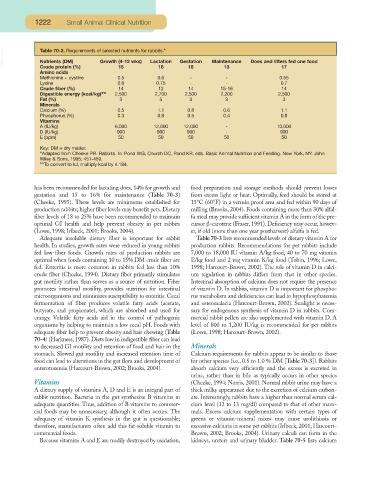Page 1172 - Small Animal Clinical Nutrition 5th Edition
P. 1172
1222 Small Animal Clinical Nutrition
VetBooks.ir Table 70-3. Requirements of selected nutrients for rabbits.* Gestation Maintenance Does and litters fed one food
Nutrients (DM)
Lactation
Growth (4-12 wks)
Crude protein (%)
Amino acids 15 18 18 13 17
Methionine + cystine 0.5 0.6 - - 0.55
Lysine 0.6 0.75 - - 0.7
Crude fiber (%) 14 12 14 15-16 14
Digestible energy (kcal/kg)** 2,500 2,700 2,500 2,200 2,500
Fat (%) 3 5 3 3 3
Minerals
Calcium (%) 0.5 1.1 0.8 0.6 1.1
Phosphorus (%) 0.3 0.8 0.5 0.4 0.8
Vitamins
A (IU/kg) 6,000 12,000 12,000 - 10,000
D (IU/kg) 900 900 900 - 900
E (ppm) 50 50 50 50 50
Key: DM = dry matter.
*Adapted from Cheeke PR. Rabbits. In: Pond WG, Church DC, Pond KR, eds. Basic Animal Nutrition and Feeding. New York, NY: John
Wiley & Sons, 1995; 451-459.
**To convert to kJ, multiply kcal by 4.184.
has been recommended for lactating does, 14% for growth and food preparation and storage methods should prevent losses
gestation and 15 to 16% for maintenance (Table 70-3) from excess light or heat. Optimally, feed should be stored at
(Cheeke, 1995). These levels are minimums established for 15°C (60°F) in a vermin proof area and fed within 90 days of
production rabbits; higher fiber levels may benefit pets. Dietary milling (Brooks, 2004). Foods containing more than 30% alfal-
fiber levels of 18 to 25% have been recommended to maintain fa meal may provide sufficient vitamin A in the form of the pre-
optimal GI health and help prevent obesity in pet rabbits cursor β-carotene (Fraser, 1991). Deficiency may occur, howev-
(Lowe, 1998; Irlbeck, 2001; Brooks, 2004). er, if old (more than one year postharvest) alfalfa is fed.
Adequate insoluble dietary fiber is important for rabbit Table 70-3 lists recommended levels of dietary vitamin A for
health. In studies, growth rates were reduced in young rabbits production rabbits. Recommendations for pet rabbits include
fed low-fiber foods. Growth rates of production rabbits are 7,000 to 18,000 IU vitamin A/kg food, 40 to 70 mg vitamin
optimal when foods containing 10 to 15% DM crude fiber are E/kg food and 2 mg vitamin K/kg food (Tobin, 1996; Lowe,
fed. Enteritis is more common in rabbits fed less than 10% 1998; Harcourt-Brown, 2002). The role of vitamin D in calci-
crude fiber (Cheeke, 1994). Dietary fiber primarily stimulates um regulation in rabbits differs from that in other species.
gut motility rather than serves as a source of nutrition. Fiber Intestinal absorption of calcium does not require the presence
promotes intestinal motility, provides nutrition for intestinal of vitamin D. In rabbits, vitamin D is important for phospho-
microorganisms and minimizes susceptibility to enteritis. Cecal rus metabolism and deficiencies can lead to hypophosphatemia
fermentation of fiber produces volatile fatty acids (acetate, and osteomalacia (Harcourt-Brown, 2002). Sunlight is neces-
butyrate, and propionate), which are absorbed and used for sary for endogenous synthesis of vitamin D in rabbits. Com-
energy. Volatile fatty acids aid in the control of pathogenic mercial rabbit pellets are also supplemented with vitamin D. A
organisms by helping to maintain a low cecal pH. Foods with level of 800 to 1,200 IU/kg is recommended for pet rabbits
adequate fiber help to prevent obesity and hair chewing (Table (Lowe, 1998; Harcourt-Brown, 2002).
70-4) (Harkness, 1987). Diets low in indigestible fiber can lead
to decreased GI motility and retention of food and hair in the Minerals
stomach. Slowed gut motility and increased retention time of Calcium requirements for rabbits appear to be similar to those
food can lead to alterations in the gut flora and development of for other species (i.e., 0.5 to 1.0 % DM [Table 70-3]). Rabbits
enterotoxemia (Harcourt-Brown, 2002; Brooks, 2004). absorb calcium very efficiently and the excess is excreted in
urine, rather than in bile as typically occurs in other species
Vitamins (Cheeke, 1994; Norris, 2001). Normal rabbit urine may have a
A dietary supply of vitamins A, D and E is an integral part of thick milky appearance due to the excretion of calcium carbon-
rabbit nutrition. Bacteria in the gut synthesize B vitamins in ate. Interestingly, rabbits have a higher than normal serum cal-
adequate quantities. Thus, addition of B vitamins to commer- cium level (12 to 13 mg/dl) compared to that of other mam-
cial foods may be unnecessary, although it often occurs. The mals. Excess calcium supplementation with certain types of
adequacy of vitamin K synthesis in the gut is questionable; greens or vitamin-mineral mixes may cause urolithiasis or
therefore, manufacturers often add this fat-soluble vitamin to excessive calciuria in some pet rabbits (Irlbeck, 2001; Harcourt-
commercial foods. Brown, 2002; Brooks, 2004). Urinary calculi can form in the
Because vitamins A and E are readily destroyed by oxidation, kidneys, ureters and urinary bladder. Table 70-5 lists calcium

